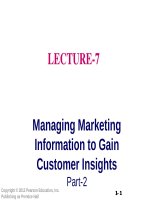Lecture fundamentals of marketing - Lecture 7: Managing marketing information to gain customer insights (Part 2)
Bạn đang xem bản rút gọn của tài liệu. Xem và tải ngay bản đầy đủ của tài liệu tại đây (228.53 KB, 31 trang )
LECTURE7
Managing Marketing
Information to Gain
Customer Insights
Copyright © 2012 Pearson Education, Inc.
Publishing as Prentice Hall
Part-2
11- 11
Developing Marketing
Information
•
Marketing Research
•
Research Instruments
Copyright © 2012 Pearson Education, Inc.
Publishing as Prentice Hall
1- 2
Qualitative Measures
§
Word association
§
§
Projective techniques
§
§
Give people an incomplete stimulus & ask them to complete it.
Visualization
§
§
Asks subjects what words come to mind when they hear the
brand’s name.
Requires people to create a collage from magazine photo or
drawings to depict their perceptions.
Brand personification
Ask subjects what kind of person they think of when the brand in
mentioned.
Copyright © 2012
Pearson Education, Inc.
1- 3
§
Publishing as Prentice Hall
Technological Devices
§
Galvanometers
§
§
Tachistoscope
§
§
Measure the interest or emotions aroused by
exposure to specific ad or picture.
Flashes an ad to a subject with an exposure
interval that range from less than one
hundredth of a second to several seconds.
Eye cameras
Study respondents eye movements to see
where their eyes land first, how long they
Copyright © 2012 Pearson Education, Inc.
1- 4
linger on a given item.
Publishing as Prentice Hall
§
Technological Devices…
§
Audiometers
§
§
Attached to TV sets in participating
homes record when the set on & to
which channel is tuned.
GPS
§
Global Positioning System – How
many billboards a person may walk by
or drive by during a day.
Copyright © 2012 Pearson Education, Inc.
Publishing as Prentice Hall
1- 5
Step 2: Develop the Research
Plan…
Sampling Plan
§
Sampling unit:
§
§
Sample size:
§
§
Who is to be surveyed?
How many people should be surveyed?
Sampling procedure:
§
How should the respondents be chosen?
Copyright © 2012 Pearson Education, Inc.
Publishing as Prentice Hall
1- 6
Types of Samples
§
§
Probability
Samples
Simple random
§
§
§
Every member of the population
has an equal chance of selection.
Stratified random
§
§
§
The population is divided into
mutually exclusive groups i.e. age
group & random sample drawn
from each group.
Cluster
§
The population is divided into
Copyright © 2012 Pearson Education, Inc.
mutually exclusive groups i.e. city
Publishing as Prentice Hall
Convenience
§
The researcher selects the most
accessible population members.
Judgment
§
§
§
Nonprobability
Samples
The researcher selects population
members who are good prospects for
accurate information.
Quota
§
The researcher find & interviews a
prescribed number of people in each
1- 7
of several categories.
Step 2: Develop the Research
Plan…
Contact Methods
§
Mail questionnaire
§
Telephone interview
§
Personal interview
§
Online interview
Copyright © 2012 Pearson Education, Inc.
Publishing as Prentice Hall
1- 8
•
•
Developing Marketing
Information
Marketing Research
Strengths and
Weakness of Contact Methods
Telephone
Personal
Online
Flexibility
Poor
Good
Excellent
Good
Quantity of data
collected
Good
Fair
Excellent
Good
Control of
interviewer effects
Excellent
Fair
Poor
Fair
Control of sample
Fair
Excellent
Good
Excellent
Speed of data
collection
Poor
Excellent
Good
Excellent
Response rate
Poor
Poor
Good
Good
Cost
Good
Fair
Poor
Excellent
Copyright © 2012 Pearson Education, Inc.
Publishing as Prentice Hall
1- 9
Developing Marketing Information
•
•
Marketing Research
Contact Methods
§
Focus Groups
§
Six to 10 people
§
Trained moderator
§
Challenges
§
Expensive
§
Difficult to generalize from small group
§
Consumers not always open and honest
Copyright © 2012 Pearson Education, Inc.
Publishing as Prentice Hall
1- 10
Developing Marketing Information
•
Marketing Research
•
Online Contact Methods
Copyright © 2012 Pearson Education, Inc.
Publishing as Prentice Hall
1- 11
Developing Marketing Information
•
Marketing Research
•
Online Contact Methods
Copyright © 2012 Pearson Education, Inc.
Publishing as Prentice Hall
1- 12
Developing Marketing Information
•
Marketing Research
•
Online Contact Methods
Copyright © 2012 Pearson Education, Inc.
Publishing as Prentice Hall
1- 13
Step 3: Collect the Information
§
§
The data collection phase of marketing
research is generally the most expensive
and the most prone to error.
Data collection methods are rapidly
improving thanks to computers and
telecommunications.
Copyright © 2012 Pearson Education, Inc.
Publishing as Prentice Hall
1- 14
Step 4: Analyze the Information
§
The next to last step in the process is to
extract findings by tabulating the data and
developing frequency distributions.
Copyright © 2012 Pearson Education, Inc.
Publishing as Prentice Hall
1- 15
Step 5: Present the findings
§
As the last step, the researcher present
findings relevant to major marketing
decisions facing management.
Copyright © 2012 Pearson Education, Inc.
Publishing as Prentice Hall
1- 16
Developing Marketing
Information
•
Marketing Research
•
Implementing the Research Plan
Copyright © 2012 Pearson Education, Inc.
Publishing as Prentice Hall
1- 17
What is Customer
Relationship Management?
CRM is the process of carefully
managing detailed information about
individual customers and all customer
touch points to maximize customer
loyalty.
Copyright © 2012 Pearson Education, Inc.
Publishing as Prentice Hall
1- 18
Analyzing and Using Marketing
Information
•
Customer Relationship Management
•
Touch points
Copyright © 2012 Pearson Education, Inc.
Publishing as Prentice Hall
1- 19
Framework for CRM
§
§
§
§
Identify your prospects and customers.
Differentiate customers by needs and
value to your company.
Interact with individual customers to
improve your knowledge about their
individual needs & to build strong
relationship.
Customize products, services and
messages to each customer.
Copyright © 2012 Pearson Education, Inc.
Publishing as Prentice Hall
1- 20
CRM Strategies
§
§
§
§
Reduce the rate of customer defection.
Increase the longevity of the customer
relationship
Enhance the growth potential of each
customer through “share of wallet” cross
selling, & up-selling.
Making low profit customers move
profitable or terminating them.
Focusing more effort on high-profit1- 21
§
Copyright © 2012 Pearson Education, Inc.
Publishing as Prentice Hall
Customer Retention- A tale
from real life
§
§
§
§
Acquisition of customers can cost 5 times
more than retaining current customers.
The average company loses 10% of its
customers each year.
A 5% reduction to the customer defection
rate can increase profits by 25% to 85%.
The customer profit rate increases over
the life of a retained customer.
Copyright © 2012 Pearson Education, Inc.
Publishing as Prentice Hall
1- 22
Database Key Concepts
§
§
§
Customer
database
Database
marketing
§
Business
database
§
Data warehouse
§
Data mining
Mailing list
Copyright © 2012 Pearson Education, Inc.
Publishing as Prentice Hall
1- 23
Using the Database
§
To identify prospects
§
To target offers
§
To deepen loyalty
§
To reactivate customers
§
To avoid mistakes
Copyright © 2012 Pearson Education, Inc.
Publishing as Prentice Hall
1- 24
Don’t Build a Database When
§
The product is a once-in-a-lifetime
purchase
§
Customers do not show loyalty
§
The unit sale is very small
§
The cost of gathering information is too
high
Copyright © 2012 Pearson Education, Inc.
Publishing as Prentice Hall
1- 25









